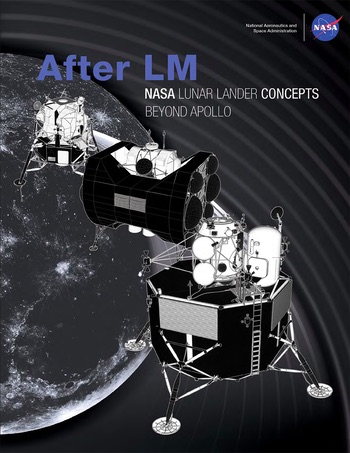 |
by Jeff Foust
Monday, June 8, 2020
After LM: NASA Lunar Lander Concepts Beyond Apollo
by John Connolly
NASA, 2020
ebook, 277 pp.
ISBN 978-0-578-62272-9
Free
When NASA announced the winners of Human Landing System (HLS) awards at the end of April (see “Can NASA land humans on the Moon by 2024?”, The Space Review, May 18, 2020), one thing that was immediately obvious was the diversity of designs. SpaceX proposed a version of its Starship reusable launch vehicle, offering a lander far larger than its counterparts, and one so tall that astronauts would descend to the lunar surface not using a ladder but instead on an elevator. Dynetics, by contrast, proposed a lander with a low-slung crew cabin ringed by drop tanks. Only the “national team” led by Blue Origin offered a lander that looked like a descendent of the Apollo program’s Lunar Module, with an ascent stage mounted on top of a descent stage.
| What the book illustrates is that, when it comes to lunar lander designs, there is very little new under the Sun—or, rather, on the surface of the Moon. |
The HLS designs are the latest in a long line of concepts for crewed human landers. For decades, NASA, industry, and academia have studied lunar landers, with surges of activity around the time of the Space Exploration Initiative in the early 1990s and the Vision for Space Exploration in the 2000s. After LM, as the title suggests, compiles some background information, technical specifications, and illustrations of many of these concepts, showing both the wide range of landers considered and how some of those designs matured, particularly during the Constellation program.
John Connolly, who has spent 33 years at NASA, much of that working on lunar landers, notes there was little work on lunar lander concepts at NASA for years after Apollo. By the late 1980s, though, there was some design work resuming on lunar landers, which continued into the 1990s, such as the First Lunar Outpost and Decadal Planning Team. However, it was President George W. Bush’s announcement of the Vision for Space Exploration, and NASA’s implementation of it through the Constellation program, that ignited a wave of lander studies both within NASA and by companies and organizations that make up most of the book. That work led to the Altair lander concept that was still being refined when the Obama administration cancelled the Constellation program in 2010.
What the book illustrates is that, when it comes to lunar lander designs, there is very little new under the Sun—or, rather, on the surface of the Moon. Using liquid hydrogen and liquid oxygen for the lander’s engines, like on Blue Moon’s lander but unlike the storable propellants used by the LM? Lander concepts going back to the late ’80s used the same propellants; others used liquid oxygen and methane, like SpaceX’s Starship. Some of the early Constellation concepts examined landers ringed by drop tanks, or which used descent stages that were discarded on the way to the lunar surface. And while some designs looked for ways to get the astronauts as close as possible to the surface, as least one concept decided to instead to include an “EVAtor”, or external elevator like on SpaceX’s design, albeit not nearly as long as the one on Starship.
| Novel ideas and sound engineering are alone insufficient to build lunar landers: political will, and funding, is also required. |
There’s plenty of other innovations exhibited in the designs. Teams at both the Goddard Space Flight Center and the Jet Propulsion Laboratory proposed using “skycrane” devices for lowering landers to the surface, like that used to land the Curiosity rover (and, next year, the Perseverance rover) on Mars. The JPL team also envisioned a mobile lander, using a six-wheel design adapted from a project called ATHLETE, or All-Terrain, Hex-Limbed, Extra-Terrestrial Explorer. At the Johnson Space Center, they studied a concept called “HabiTank” that would turn liquid hydrogen tanks in the descent stage into habitat modules after landing.
After LM is a fascinating examination of lunar lander concepts, particularly those with a technical bent; the book provides detailed tables of mass breakdowns and other characteristics of the lander concepts. Its abrupt ending, though, as NASA is refining the Altair lander design, is a reminder that novel ideas and sound engineering are alone insufficient to build lunar landers: political will, and funding, is also required.
That’s made clear in a narrative included in the book written by a team at the Langley Research Center that developed a lander called Descent Assisted Split Habitat. That narrative, written at the time the study was performed in 2006, was in the form a fictional account of that lander safely transporting NASA astronauts to the lunar surface for the first time since Apollo. The date of that fictional landing: September 30, 2020.
Note: we are temporarily moderating all comments submitted to deal with a surge in spam.
"Review" - Google News
June 09, 2020 at 04:36AM
https://ift.tt/3f4O4YU
Review: After LM - The Space Review
"Review" - Google News
https://ift.tt/2YqLwiz
https://ift.tt/3c9nRHD
Bagikan Berita Ini














0 Response to "Review: After LM - The Space Review"
Post a Comment